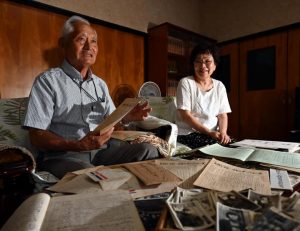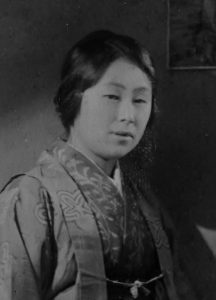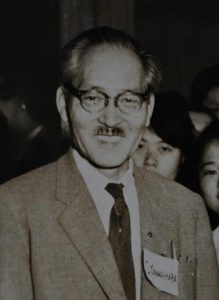Newly discovered materials from early days of A-bomb survivors support group highlight former secretary-general’s efforts to link anti-war Japan, US citizens
Aug. 4, 2023
by Michiko Tanaka, Senior Staff Writer
During the so-called “lost decade” of little aid for A-bomb survivors from Japan’s national government, citizens in both Japan and United States worked to provide their own support. Remaining documents involving the Hiroshima Peace Center, located in the city, reveal the image of a man who was devoted to the support of A-bomb orphans and women survivors.
“I don’t like to boast, but I respect my father. I can’t live up to the standard he set,” said Arihiro Yanagihara, 80, a resident of Hiroshima’s Asaminami Ward, as he recalled his father, Shigeto Yanagihara, who served as secretary-general of the organization. Rereading the documents that had been forgotten in a storehouse at his home, Arihiro remembered his father as someone who had devoted his life to behind-the-scenes support of A-bomb survivors.
When Arihiro was a child, the sounds of a typewriter would emanate day and night from his father’s room. The work engaged in by his father was apparently the translation of large volumes of letters exchanged between Japan and the United States. The organization’s fiscal 1955 business statement mentions that the secretary-general handled three or four posts on his own. Despite the hard work, he never once complained. “Experiencing the atomic bombing, he must have made up his mind to live his life for A-bomb survivors,” said Arihiro.
Shigeto Yanagihara was born in the village of Kawauchi (now part of the Kawauchi district of Hiroshima’s Asaminami Ward) in 1900. Following in the footsteps of his father, who had traveled overseas in search of work, Shigeto went to North America around 1916. He studied physics and mathematics at a university. An album of photographs from that time reveals the smiling Shigeto, who loved the sense of freedom that characterized the United States. After his return to Japan in 1930, however, the United States became Japan’s enemy.
More than 180 residents mobilized from Kawauchi to work near the hypocenter as part of the town’s Volunteer Fighting Corps died in the atomic bombing. At the time of the A-bombing, Shigeto, his wife, one daughter, and two sons were living with his parents. He worked at a munitions factory, and his wife, Mitsuko, 37 at the time, was a member of the Volunteer Fighting Corps.
Immediately after returning home the day of the bombing from the factory where he worked, Shigeto headed for the city center. He went there day after day until the end of the month but was unable to find even the remains of his wife. His son, Arihiro, was then two years old. “My father would never talk about his memories at that time. It must have been too painful for him,” Arihiro surmised.
Two years after the end of the war, Shigeto started working at the Kure Branch of the Chugoku Financial Bureau. Requested by the Hiroshima Nagarekawa Church’s Reverend Kiyoshi Tanimoto, who died in 1986 at the age of 77, Shigeto began to assist in the activities of the Hiroshima Peace Center, which was established in 1950. Disheartened by the circumstances in which A-bomb orphans found themselves, he put great effort into what was called the “moral adoption” movement, which linked A-bomb orphans and supporters in the United States. He opened his home and a farm in Kawauchi as places for orphans to live and encouraged and helped them become independent. His new wife, Kimie, who died in 1987 at the age of 76, also provided support for the work.
Arihiro said he feels that his father “didn’t resent the United States. Instead, he thought that exchanges between citizens of Japan and the United States would be a means of preventing war.” Shigeto himself wrote in the March 1956 edition of the Hiroshima Peace Center News, “If we forgive and understand each other, genuine peace will surely come to the world.”
Shigeto died of stomach cancer at the age of 75. After retiring as a junior high school teacher, Arihiro became president of the Kawauchi Volunteer Fighting Corps bereaved families association. In recent years, he has walked around his community collecting photos of A-bomb victims and displayed them at a memorial service held on August 6 in front of a monument in Peace Memorial Park. “It’s probably my father’s influence. I feel a responsibility to convey what happened in Hiroshima that day to future generations,” explained Arihiro.
Arihiro was not only influenced by his family. The documents he discovered included a photo of Shigeto in his later years alongside a smiling young man. The young man was an A-bomb orphan who had been rescued by an American woman to whom he had been introduced by Shigeto.
(Originally published on August 4, 2023)
During the so-called “lost decade” of little aid for A-bomb survivors from Japan’s national government, citizens in both Japan and United States worked to provide their own support. Remaining documents involving the Hiroshima Peace Center, located in the city, reveal the image of a man who was devoted to the support of A-bomb orphans and women survivors.
“I don’t like to boast, but I respect my father. I can’t live up to the standard he set,” said Arihiro Yanagihara, 80, a resident of Hiroshima’s Asaminami Ward, as he recalled his father, Shigeto Yanagihara, who served as secretary-general of the organization. Rereading the documents that had been forgotten in a storehouse at his home, Arihiro remembered his father as someone who had devoted his life to behind-the-scenes support of A-bomb survivors.
When Arihiro was a child, the sounds of a typewriter would emanate day and night from his father’s room. The work engaged in by his father was apparently the translation of large volumes of letters exchanged between Japan and the United States. The organization’s fiscal 1955 business statement mentions that the secretary-general handled three or four posts on his own. Despite the hard work, he never once complained. “Experiencing the atomic bombing, he must have made up his mind to live his life for A-bomb survivors,” said Arihiro.
Shigeto Yanagihara was born in the village of Kawauchi (now part of the Kawauchi district of Hiroshima’s Asaminami Ward) in 1900. Following in the footsteps of his father, who had traveled overseas in search of work, Shigeto went to North America around 1916. He studied physics and mathematics at a university. An album of photographs from that time reveals the smiling Shigeto, who loved the sense of freedom that characterized the United States. After his return to Japan in 1930, however, the United States became Japan’s enemy.
More than 180 residents mobilized from Kawauchi to work near the hypocenter as part of the town’s Volunteer Fighting Corps died in the atomic bombing. At the time of the A-bombing, Shigeto, his wife, one daughter, and two sons were living with his parents. He worked at a munitions factory, and his wife, Mitsuko, 37 at the time, was a member of the Volunteer Fighting Corps.
Immediately after returning home the day of the bombing from the factory where he worked, Shigeto headed for the city center. He went there day after day until the end of the month but was unable to find even the remains of his wife. His son, Arihiro, was then two years old. “My father would never talk about his memories at that time. It must have been too painful for him,” Arihiro surmised.
Two years after the end of the war, Shigeto started working at the Kure Branch of the Chugoku Financial Bureau. Requested by the Hiroshima Nagarekawa Church’s Reverend Kiyoshi Tanimoto, who died in 1986 at the age of 77, Shigeto began to assist in the activities of the Hiroshima Peace Center, which was established in 1950. Disheartened by the circumstances in which A-bomb orphans found themselves, he put great effort into what was called the “moral adoption” movement, which linked A-bomb orphans and supporters in the United States. He opened his home and a farm in Kawauchi as places for orphans to live and encouraged and helped them become independent. His new wife, Kimie, who died in 1987 at the age of 76, also provided support for the work.
Arihiro said he feels that his father “didn’t resent the United States. Instead, he thought that exchanges between citizens of Japan and the United States would be a means of preventing war.” Shigeto himself wrote in the March 1956 edition of the Hiroshima Peace Center News, “If we forgive and understand each other, genuine peace will surely come to the world.”
Shigeto died of stomach cancer at the age of 75. After retiring as a junior high school teacher, Arihiro became president of the Kawauchi Volunteer Fighting Corps bereaved families association. In recent years, he has walked around his community collecting photos of A-bomb victims and displayed them at a memorial service held on August 6 in front of a monument in Peace Memorial Park. “It’s probably my father’s influence. I feel a responsibility to convey what happened in Hiroshima that day to future generations,” explained Arihiro.
Arihiro was not only influenced by his family. The documents he discovered included a photo of Shigeto in his later years alongside a smiling young man. The young man was an A-bomb orphan who had been rescued by an American woman to whom he had been introduced by Shigeto.
(Originally published on August 4, 2023)










